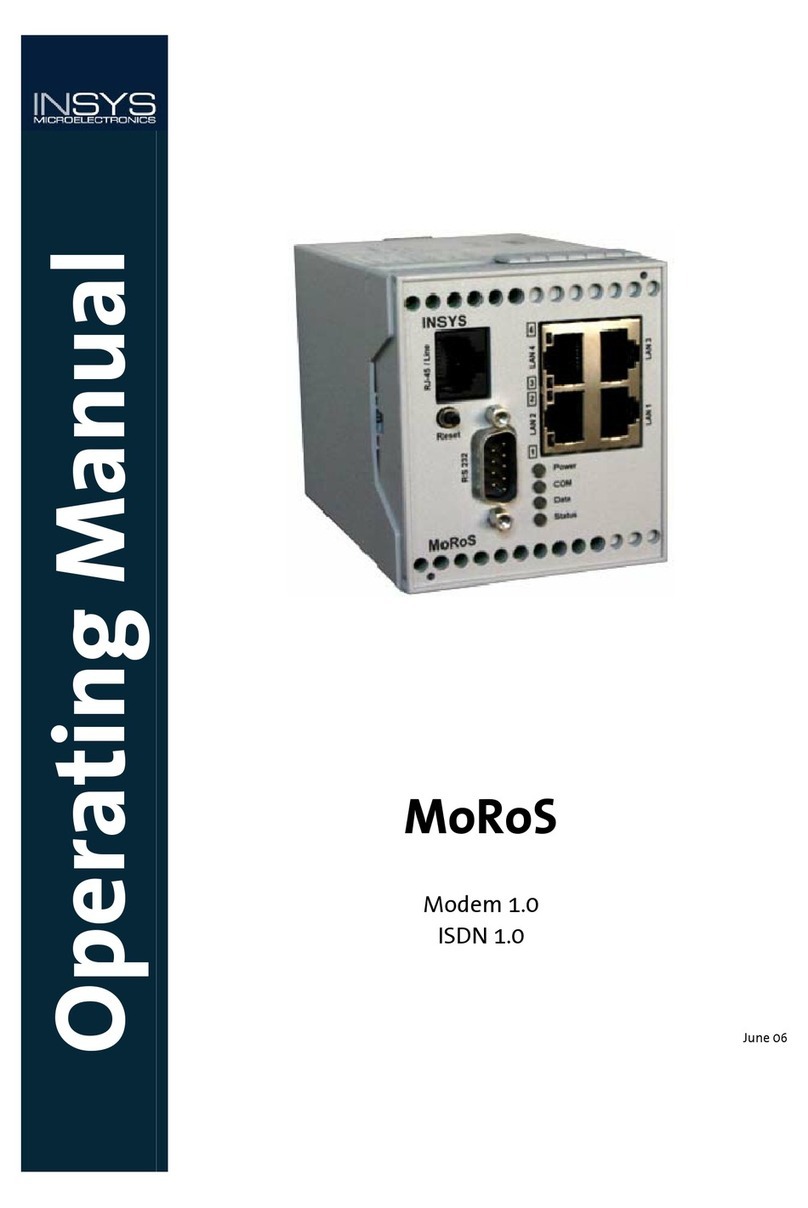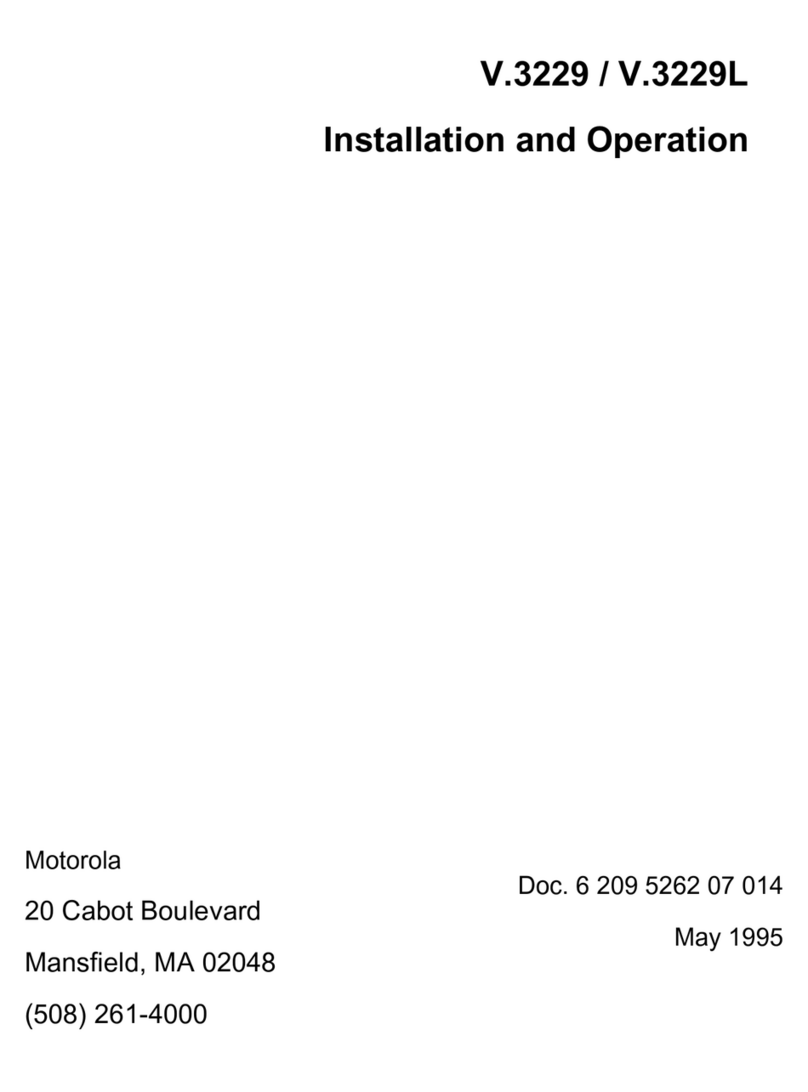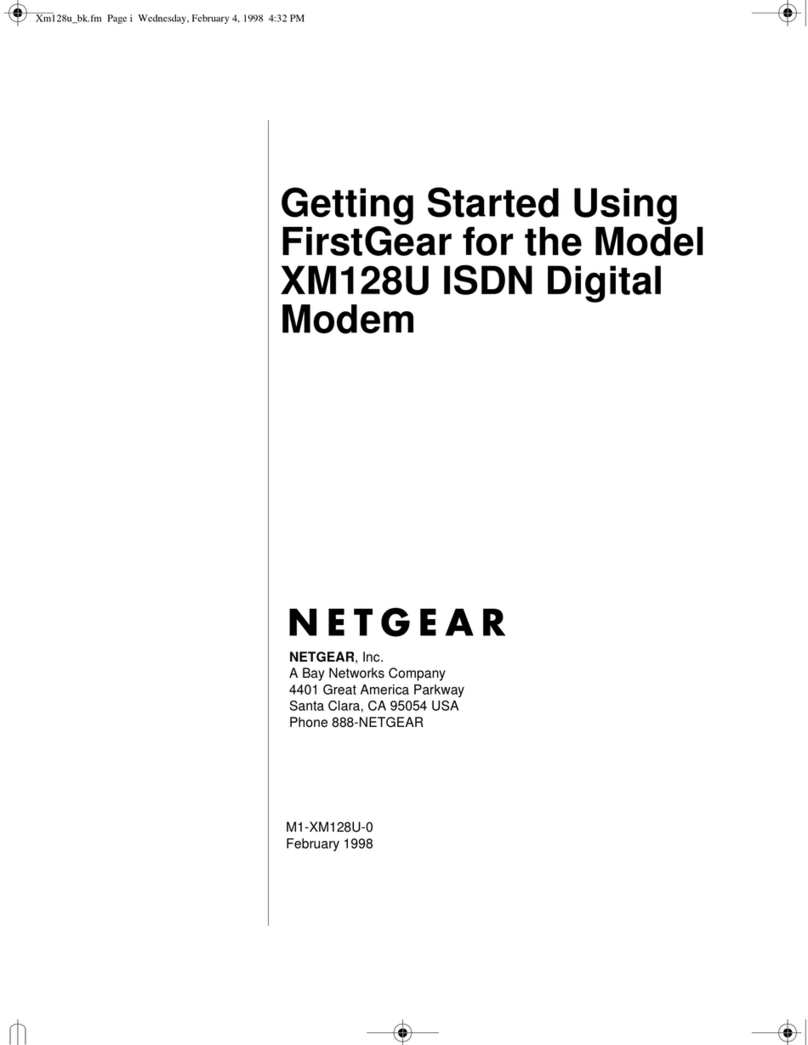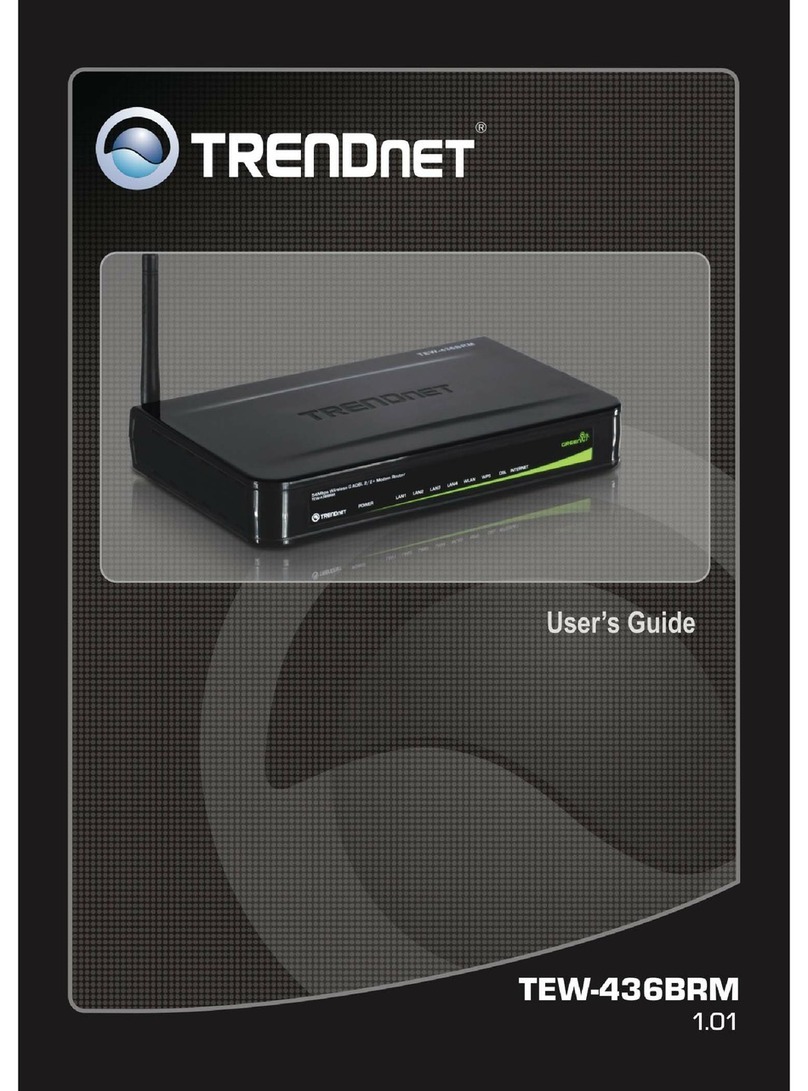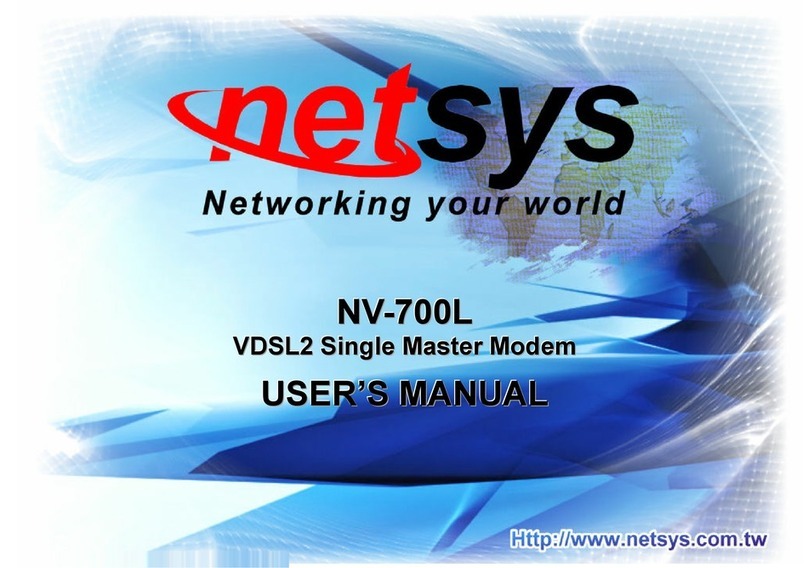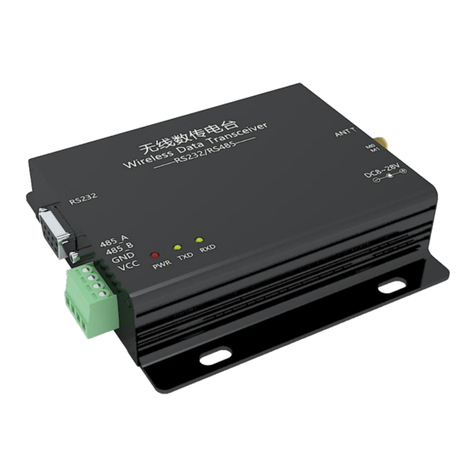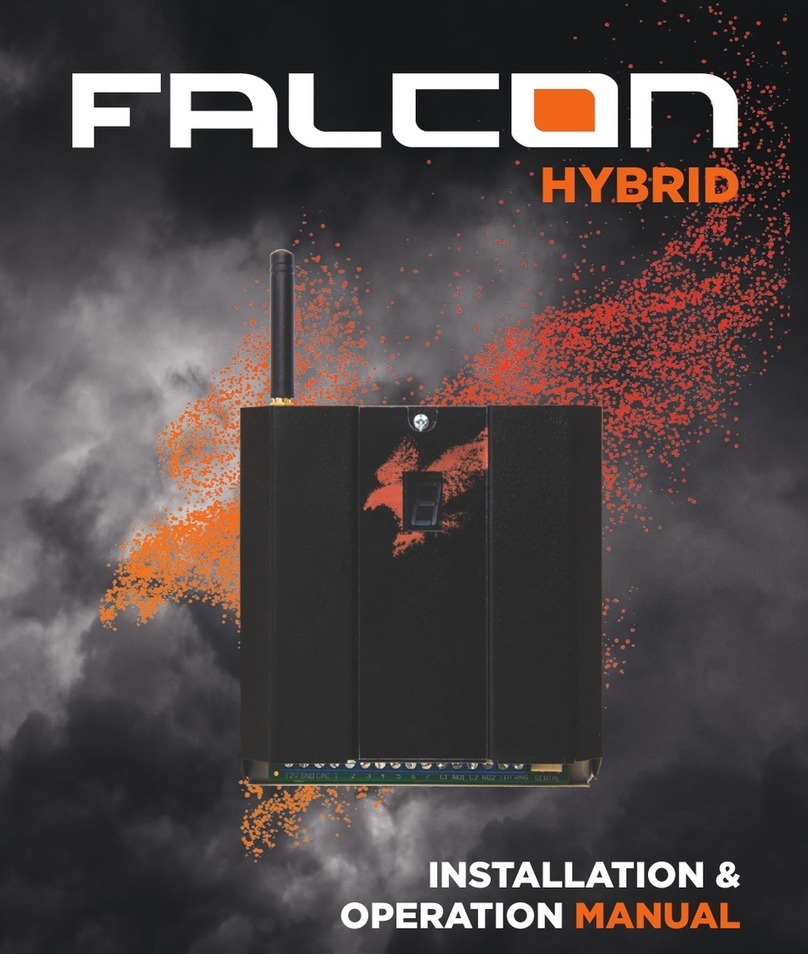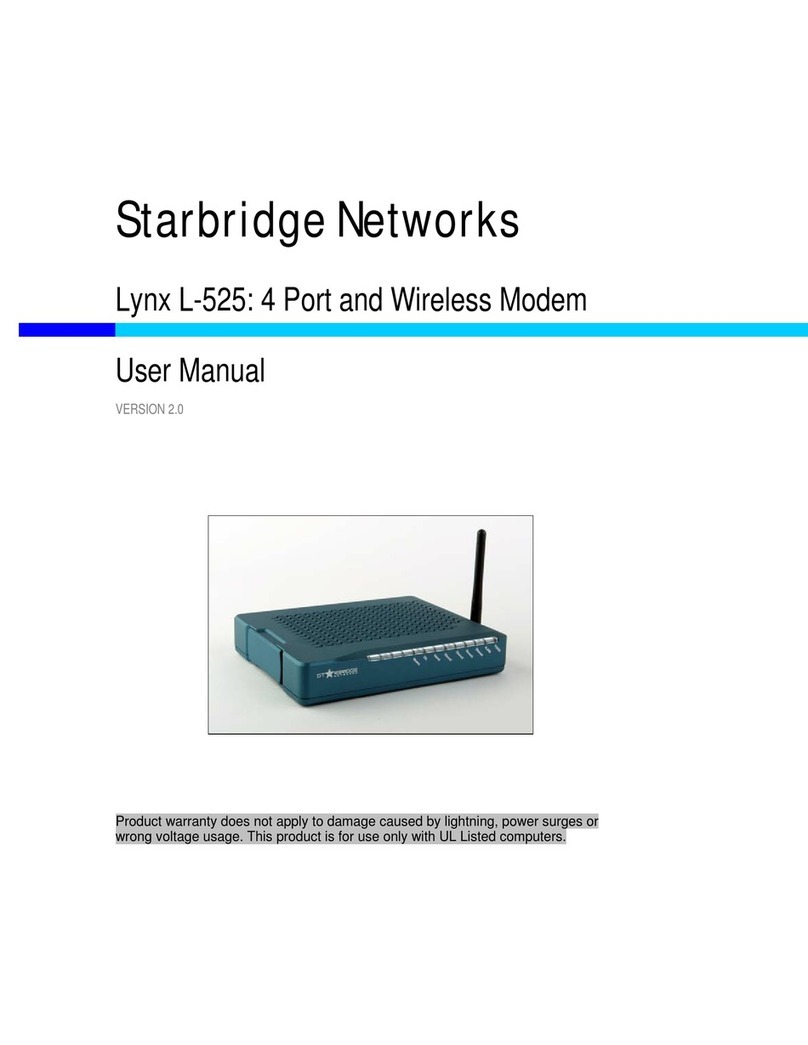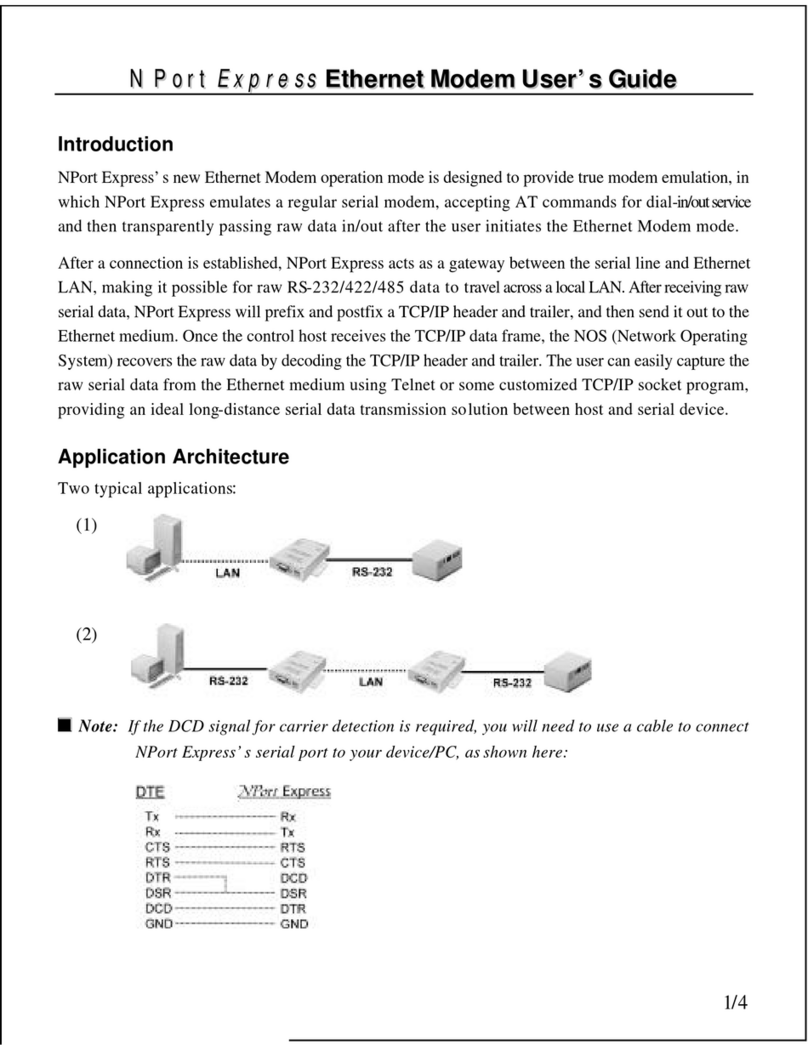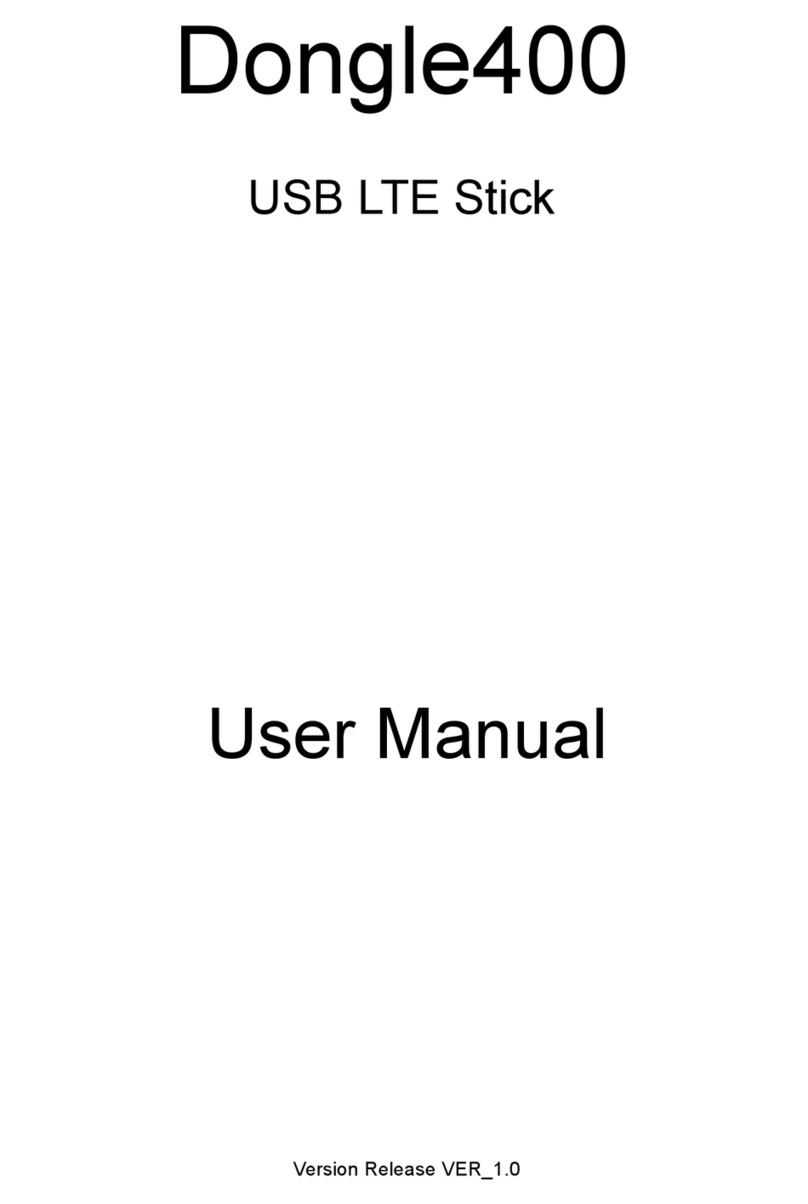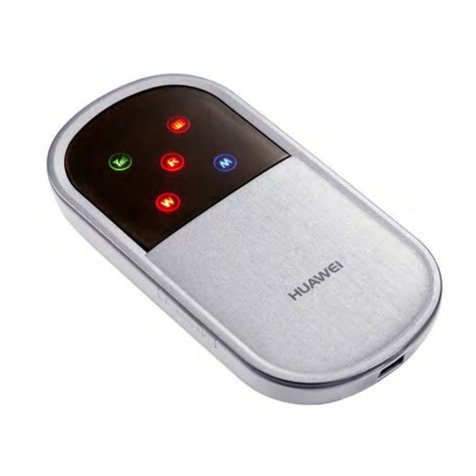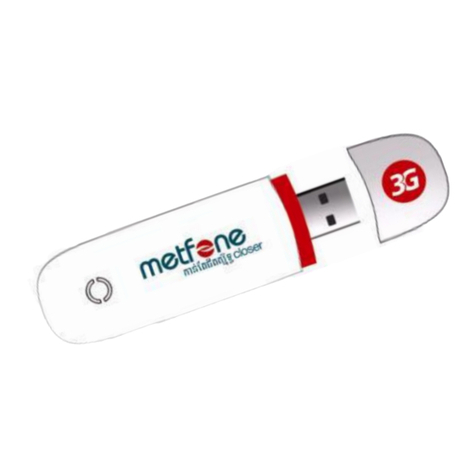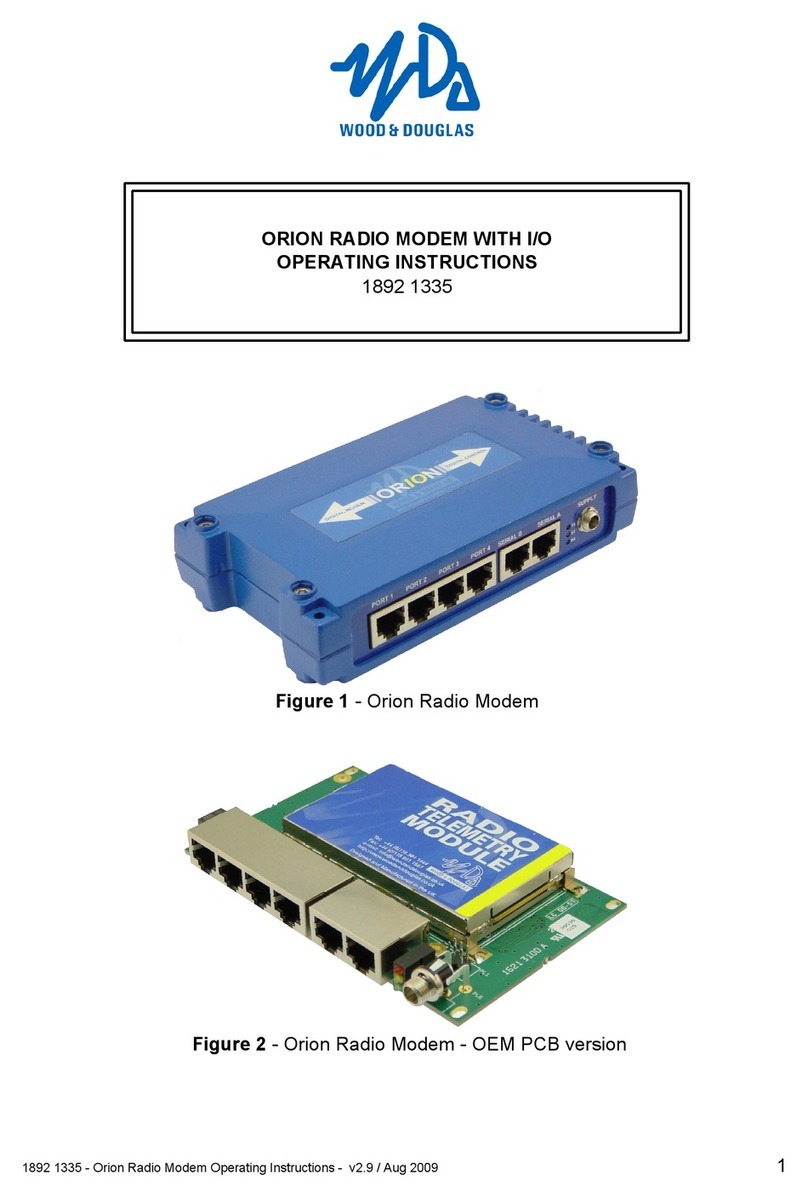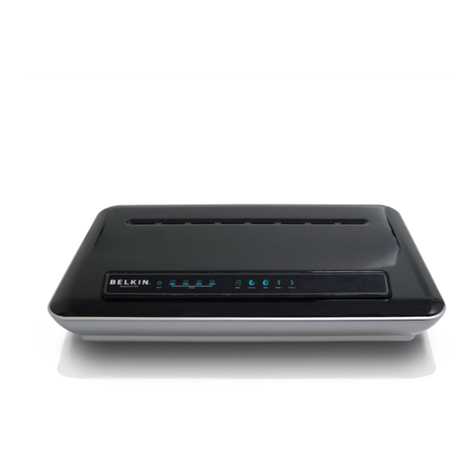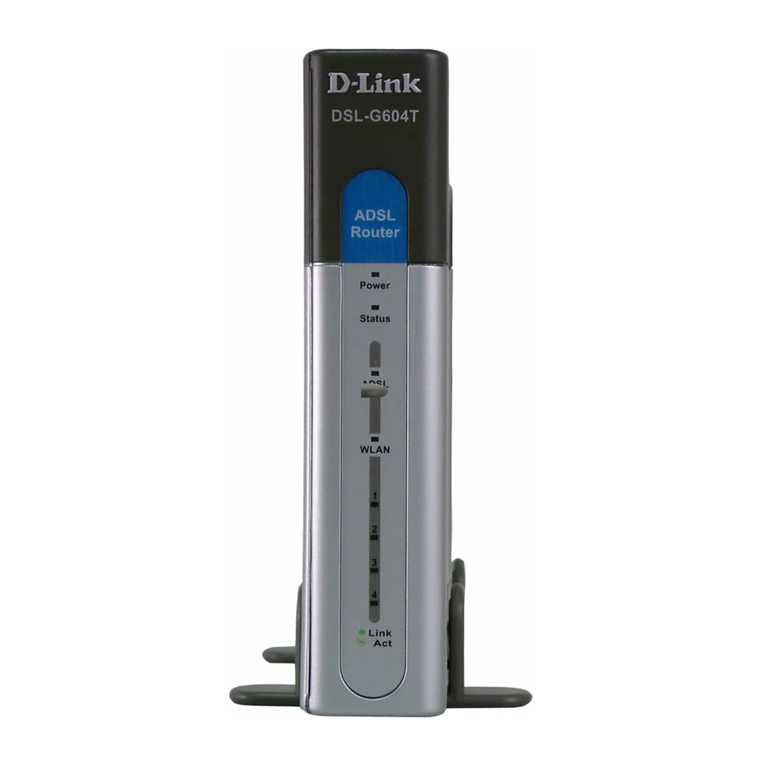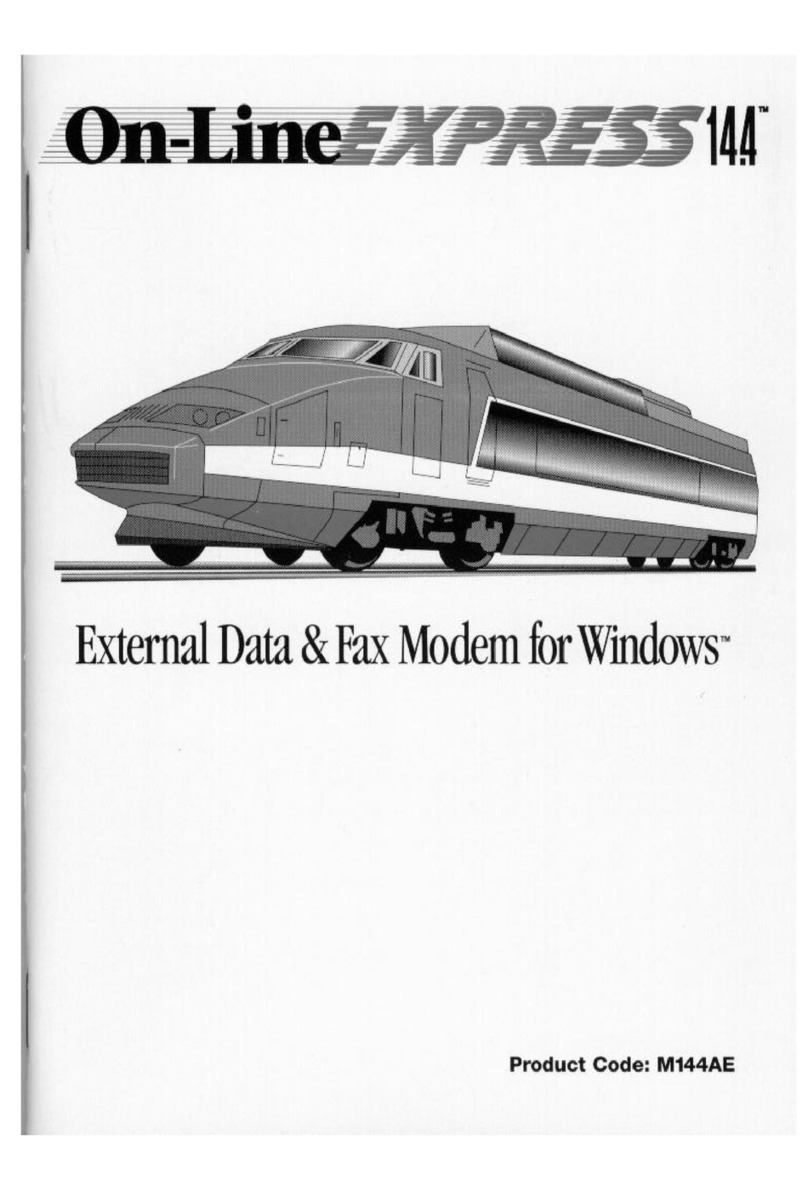INSYS 56k small EU 2.1 User manual

Manual
INSYS Modem 56k
small EU 2.1
Sep-09


Copyright © September 09 INSYS MICROELECTRONICS GmbH
Any duplication of this manual is prohibited. All rights on this documentation and the
devices are with INSYS MICROELECTRONICS GmbH Regensburg.
Trademarks
The use of a trademark not shown below is not an indication that it is freely available for
use.
MNP is a registered trademark of Microcom Inc.
IBM PC, AT, XT are registered trademarks of International Business Machine Corporation.
INSYS ® is a registered trademark of INSYS MICROELECTRONICS GmbH.
Windows™ is a registered trademark of Microsoft Corporation.
Linux is a registered trademark of Linus Torvalds.
Publisher:
INSYS MICROELECTRONICS GmbH
Waffnergasse 8
D-93047 Regensburg, Germany
Phone: +49 (0)941/56 00 61
Fax: +49 (0)941/56 34 71
Internet: http://www.insys-tec.de
Date: Sep-09
Item: 31-22-03.101
Version: 1.0
Language: EN

Contents
4Sep-09
1Safety .................................................................................................................. 6
2Scope of Delivery ................................................................................................ 8
3Usage According to the Regulations .................................................................. 9
4Technical Data................................................................................................... 10
4.1 Physical Features ..............................................................................................................10
4.2 Technological Features.....................................................................................................10
4.3 Certifications.....................................................................................................................11
5Display and Control Elements........................................................................... 12
5.1 Meaning of the Displays...................................................................................................12
6Connections....................................................................................................... 13
6.1 Front Panel Connections...................................................................................................13
6.2 Terminal Connections on the Top ....................................................................................13
6.3 Pin Assignment of the Serial Interface.............................................................................14
6.4 RJ12 Phone connection.....................................................................................................15
7Function Overview............................................................................................ 16
8Meaning of the Symbols and the Formatting in this Manual.......................... 17
9Installation ........................................................................................................ 18
10 Initial Operation................................................................................................ 22
11 Operating Principle........................................................................................... 24
11.1 Operation with the Terminal Program.............................................................................24
11.2 Operation with HSComm .................................................................................................25
11.3 User Interface of the Software HSComm Modem ...........................................................26
12 Functions........................................................................................................... 28
12.1 Establishing or Accepting a Data Connection..................................................................28
12.2 Automatic Baud Rate Detection.......................................................................................31
12.2.1 Serial Connection ............................................................................................................ 31
12.2.2 Phone Connection........................................................................................................... 32
12.3 Data Buffer for Serial Data Transmission.........................................................................33
12.4 Bit Direct Mode .................................................................................................................33
12.5 Data Flow Control (Handshake) .......................................................................................34
12.5.1 Hardware data flow control (RTS/CTS)...................................................................... 34
12.5.2 Software data flow control (XON/XOFF) .................................................................. 35
12.6 Error correction .................................................................................................................36
12.7 Data Compression.............................................................................................................37
12.8 Automatic Dial-Up Delay..................................................................................................38
12.9 User Profiles ......................................................................................................................39
12.9.1 Changing the Configuration ........................................................................................ 39
12.9.2 Saving the Configuration.............................................................................................. 39
12.10 Reset..................................................................................................................................40

Contents
Sep-09 5
13 Maintenance ..................................................................................................... 41
14 Waste Disposal.................................................................................................. 43
14.1 Repurchasing of Legacy Systems......................................................................................43
15 AT Command Reference ................................................................................... 44
15.1 AT Command Overview....................................................................................................45
15.2 AT Messages......................................................................................................................61
16 S Registry........................................................................................................... 64
16.1 Overview S Registry..........................................................................................................65
16.2 Description S Registry.......................................................................................................66
17 Tables and Diagrams......................................................................................... 74
17.1 List of Tables .....................................................................................................................74
17.2 List of Diagrams ................................................................................................................74
18 Index.................................................................................................................. 75

Safety INSYS Modem 56k small EU 2.1
6
1Safety
Danger!
Moisture und liquids from the environment may seep
into the interior of the device.
Risk of death through shock hazard when touching it!
The INSYS Modem 56k small EU 2.1 may not be used in
wet or damp environments, or in or very close to water.
Install the device at a dry location, protected from water
spray. Switch the power supply off before you do any
work on a device which may have been in contact with
moisture.
Danger!
Overvoltage.
Fire hazard!
The modem must be secured with a suitable fuse against
overvoltage.
Danger!
Overcurrent.
Fire hazard!
The modem must be secured with a suitable fuse against
currents exceeding 1.6 A.
Warning!
Short circuits and damage due to improper repairs and
opening of maintenance areas.
Fire, breakdown and risk of injury!
Only trained personnel are allowed to open the INSYS
Modem 56k small EU 2.1 and to repair it.
Note
Damage of the device due to overvoltage!
Voltage peaks from the power supply may damage the
device.
Install suitable overvoltage protection.

INSYS Modem 56k small EU 2.1 Safety
7
Note
Damage due to chemicals!
Ketones and chlorinated hydrocarbons dissolve the plas-
tic housing and damage the surface of the device.
Never let the device come into contact with ketones (e.g.
acetone) or chlorinated hydrocarbons, such as dichloro-
methane.

Scope of Delivery INSYS Modem 56k small EU 2.1
8
2Scope of Delivery
The scope of delivery for the INSYS Modem 56k small EU 2.1 includes all accessories listed
below. Please check if all accessories are included in the box. If a part is missing or dam-
aged, please contact your distributor.
INSYS Modem 56k small EU 2.1
Cable:
1 phone cord (TAE-N at RJ12)
1 serial cable with 9-pin sub-D plug for the connection to the PC
1 Manual

INSYS Modem 56k small EU 2.1 Usage According to the Regulations
9
3Usage According to the Regulations
The INSYS Modem 56k small EU 2.1 may only be used for the purposes specified in the
function overview. In addition, it may be used for the following purposes:
Usage and mounting in an industrial cabinet.
Switching and data transmission functions in machines according to the
machine directive 2006/42/EC.
Usage as data transmission device for a PLC.
The INSYS Modem 56k small EU 2.1 must not be used for the following purposes and
used or operated under the following conditions:
Controlling or switching of machines and systems which do not comply
with the directive 2006/42/EC.
Usage, controlling, switching and data transmission in machines or sys-
tems which are operated in explosive atmospheres.
Controlling, switching and data transmission of machines, which may in-
volve risks to life and limb due to their functions or when a breakdown oc-
curs.

Technical Data INSYS Modem 56k small EU 2.1
10
4Technical Data
4.1 Physical Features
Danger!
Overvoltage.
Fire hazard!
The modem must be secured with a suitable fuse against
overvoltage.
All specified data was measured with a nominal input voltage, at full load, and an ambi-
ent temperature of 25 °C. The threshold value tolerances are subject to typical fluctua-
tions.
Physical Feature Value
Operating voltage Minimum 10 V DC
Maximum 32 V DC
Power input sleep 2.4 W
Power input connection 2.6 W
Weight 100 g
Dimensions (Width x Depth x Height) 23 mm x 110 mm x 75 mm
Temperature range 0 °C – 55 °C
Maximum allowed humidity 95 % non-condensing
Table 1: Physical Features
4.2 Technological Features
Technological Feature Description
Protection Class Housing IP40
Terminals IP20
Supported data compression standards MNP 2/3, MNP 5, V.42 bis; V.44, MNP 10,
MNP 10 EC
Fax-Classes Fax Class 1
Modulation types V.32bis, V.32, V.23, V.22, V22 bis, V21,
V.34+, V.34, V.42, (bei 56k-Version zusätz-
lich V.90 und V.92)Bell Norm 103/212
Error correction standards MNP4, LAPM
Table 1: Technological Features

INSYS Modem 56k small EU 2.1 Technical Data
11
4.3 Certifications
The INSYS Modem 56k small EU 2.1 has been developed according to the following
guidelines and standards:
R&TTE 1999/5/EC
DIN EN 55022 Class B
DIN EN 61000-6-2
DIN EN 60950-1
CTR 21

Display and Control Elements INSYS Modem 56k small EU 2.1
12
5Display and Control Elements
Figure 1: LEDs on the front panel
Position Description
1 Power/RX/TX LED
2 OH/DCD-LED (Off Hook / Data Carrier Detect)
Table 1: Description of the LEDs on the front panel of the device
5.1 Meaning of the Displays
Description Display Meaning
Power/RX/TX LED LED on (green) Supply voltage available
LED off No supply voltage
LED blinking (orange) Data is transmitted
OH/DCD LED LED on (green) Modem is hooked to the
phone line and online.
LED off Modem is not hooked to
the phone line and offline.
LED on (red) Modem is offline, DCD line
is permanently active.
Table 2: Meaning of the LED displays

INSYS Modem 56k small EU 2.1 Connections
13
6Connections
6.1 Front Panel Connections
Figure 2: Connections on the front panel of the device
Position Description
1 Serial Interface (RS232 jack)
2 Phone connection (RJ12 line jack)
Table 1: Description of the connections on the front panel of the device
6.2 Terminal Connections on the Top
Figure 2: Connections on the top of the device
Terminal
Description Description
1 10 ... 32 V DC Power supply 10 V – 60 V DC
2 GND Ground
3 Reset Reset input
Table 3: Description of the connections on the top of the device

Connections INSYS Modem 56k small EU 2.1
14
6.3 Pin Assignment of the Serial Interface
Figure 3: 9-pin sub-D jack at the device
Pin Signal Description
1 DCD Data Carrier Detect
2 RXD Receive Data
3 TXD Transmit Data
4 DTR Data Terminal Ready
5 GND Ground
6 DSR Data set ready
7 RTS Request to send
8 CTS Clear To Send
9 RI Ring Indication
Table 4: Description of the pin allocation of the sub-D jack

INSYS Modem 56k small EU 2.1 Connections
15
6.4 RJ12 Phone connection
Figure 4: RJ12 jack connected to TAE jack
Pin Signal Description
1 E Not connected (GND)
2 a2 To connect a phone in series.
3 a1 Incoming phone line (e.g. PSTN or PBX)
4 b1 Incoming phone line (e.g. PSTN or PBX)
5 b2 To connect a phone in series.
6 W Not connected (line to external bell)
Table 5: Layout description of the RJ12 and TAE plugs
E W
b2 b1
a2 a1

Function Overview INSYS Modem 56k small EU 2.1
16
7Function Overview
The INSYS Modem 56k small EU 2.1 offers the following functions:
Automatic baud rate detection
The INSYS Modem 56k small EU 2.1 will automatically adjust the data
transmission rate, if a connection is made via its serial interface. The serial
transmission rate can be preset for applications for the serial communica-
tion to be able to initialize with a defined baud rate.
Data buffer for serial data transmission
The INSYS Modem 56k small EU 2.1 has a fast send and receive buffer
(cache) to adjust the modem to the operating speed of the application.
Bit direct mode
The INSYS Modem 56k small EU 2.1 can forward incoming data without
having any effect on the transmission format of the data.
Hardware and software data flow control
The INSYS Modem 56k small EU 2.1 can transmit to the application via the
control lines of the serial interface to interrupt the dataflow, if the buffers
of the INSYS Modem 56k small EU 2.1 exceed a certain level. An application
can also prompt the INSYS Modem 56k small EU 2.1 via a control line to in-
terrupt the data flow. As an alternative, the INSYS Modem 56k small EU
2.1 can control the data flow via XOFF/XON characters in the data stream.
Error correction
The INSYS Modem 56k small EU 2.1 has the following error correction pro-
tocols: V.42,V.42bis, V.44,MNP2, MNP3, MNP4, and MNP10
Storing the settings in the user profiles
The INSYS Modem 56k small EU 2.1 can store the user settings in two dif-
ferent "profiles". This means that two different configurations can be
stored for special purposes and loaded as needed.

INSYS Modem 56k small EU 2.1 Meaning of the Symbols and the Formatting in this
Ml
17
8Meaning of the Symbols and the Formatting in this
Manual
This section describes the definition, formatting and symbols used in this manual. The
various symbols are meant to help you read and find the information relevant to you.
The following text is structured like a typical operating instruction of this manual.
Bold print: This will tell you what the following steps will result in
After that, there will be a detailed explanation why you could perform the
following steps to be able to reach the objective indicated first. You can de-
cide whether the section is relevant for you or not.
An arrow will indicate prerequisites which must be fulfilled to be able to
process the subsequent steps in a meaningful way. You will also learn
which software or which equipment you will need.
1. One individual action step: This tells you what you need to do at this point.
The steps are numbered for better orientation.
A result which you will receive after performing a step will be marked with
a check mark. At this point, you can check if the previous steps were suc-
cessful.
Additional information which you should consider are marked with a cir-
cled "i". At this point, we will indicate possible error sources and tell you
how to avoid them.
Alternative results and steps are marked with an arrow. This will tell you how
to reach the same results performing different steps, or what you could do if
you didn't reach the expected results at this point.

Installation INSYS Modem 56k small EU 2.1
18
9Installation
This chapter describes how to mount the INSYS Modem 56k small EU 2.1 to a DIN
rail, connect it to the power supply and disassemble it again.
Danger!
Exposed electrical components!
Risk of death through electric shock hazard!
Prior to the installation, switch the power of the cabinet
off and secure it against being switched on again.
Danger!
Moisture and liquids from the environment may seep
into the interior of the INSYS Modem 56k small EU 2.1.
Risk of death through shock hazard when touched!
The INSYS Modem 56k small EU 2.1 may not be used in
wet or damp environments, or in or very close to water.
Install the device at a dry location, protected from water
spray. Switch the power supply off before you do any
work on a device which may have been in contact with
moisture.
Note
The device could be destructed if the wrong power sup-
ply is used.
If the INSYS Modem 56k small EU 2.1 is used with a
power supply which has a larger voltage than the al-
lowed operational voltage of the INSYS Modem 56k
small EU 2.1, the device is destroyed.
Make sure that you use the suitable power supply. The
Chapter "Technical Data" has the information about the
correct voltage range for the INSYS Modem 56k small EU
2.1.

INSYS Modem 56k small EU 2.1 Installation
19
Mount the device to the DIN rail
Instructions on how to mount the INSYS Modem 56k small EU 2.1 to a DIN
rail.
1. Position the device at the DIN rail as seen in the following diagram. There
are two snap-in hooks at the outer edge of the DIN rail groove of the INSYS
Modem 56k small EU 2.1. Hook them into place behind the upper edge of
the DIN rail when connecting the device.
2. Lift the INSYS Modem 56k small EU 2.1 perpendicular to the DIN rail until the
plastic spring of the third, flexible snap-in hook engages in the DIN rail.
The INSYS Modem 56k small EU 2.1 is now completely mounted.
Connecting the power supply
The device has already been mounted to the DIN rail.
The power supply is connected and switched off.
1. Connect the ground lead of the power supply to the terminal "GND".
2. Connect the plus pole of the power supply to the terminal for the power
supply.

Installation INSYS Modem 56k small EU 2.1
20
Disassemble the device from the DIN rail
Instructions on how to disassemble the INSYS Modem 56k small EU 2.1
from a DIN rail in a cabinet:
You will need a flat tip screwdriver with a 4.5 mm blade.
The power supply of the cabinet is switched off and secured against being
switched off accidentally.
All cables at the INSYS Modem 56k small EU 2.1 are disconnected.
Danger!
Exposed electrical components!
Risk of death through electric shock hazard!
Prior to the installation, switch the power of the cabinet
off and secure it against being switched on again.
1. Insert the flat tip screwdriver into the flexible snap-in hook of the INSYS Mo-
dem 56k small EU 2.1 as shown in the diagram.
2. Turn the flat tip screwdriver into the direction of the INSYS Modem 56k small
EU 2.1 as shown in the diagram.
Table of contents
Other INSYS Modem manuals
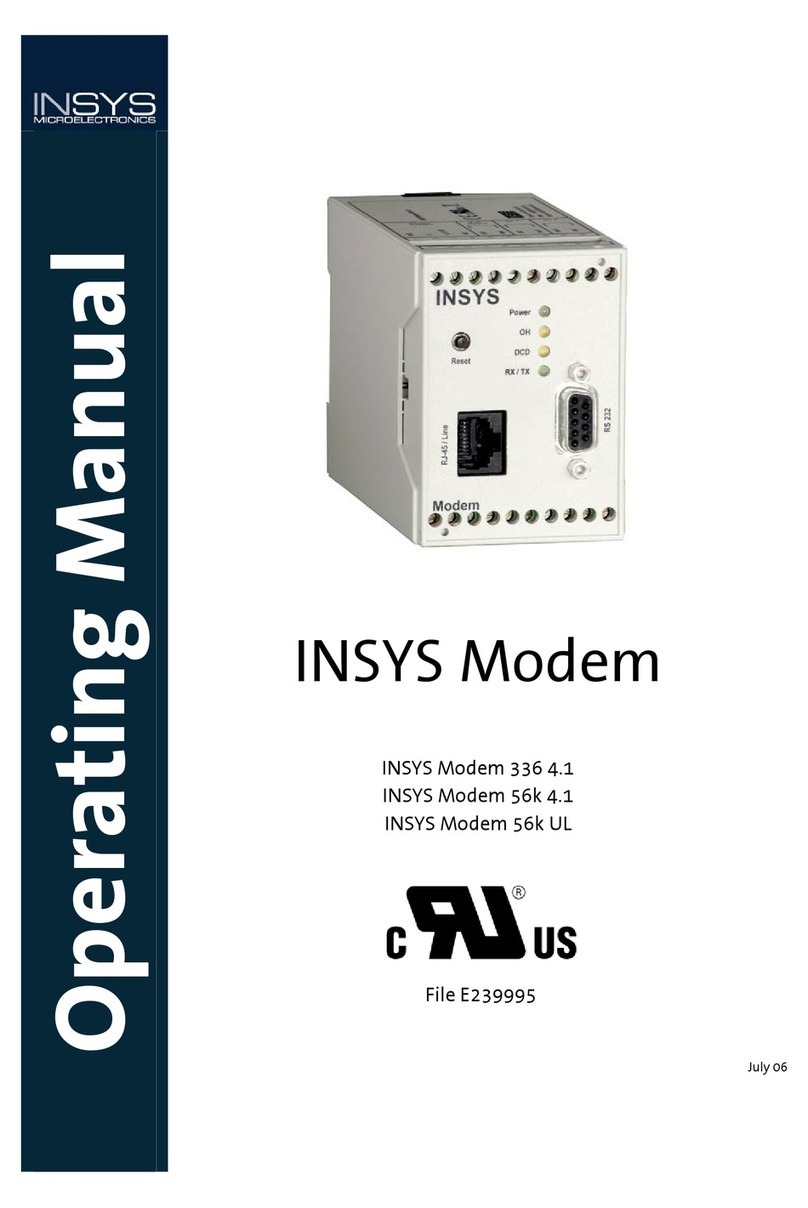
INSYS
INSYS 336 4.1 User manual
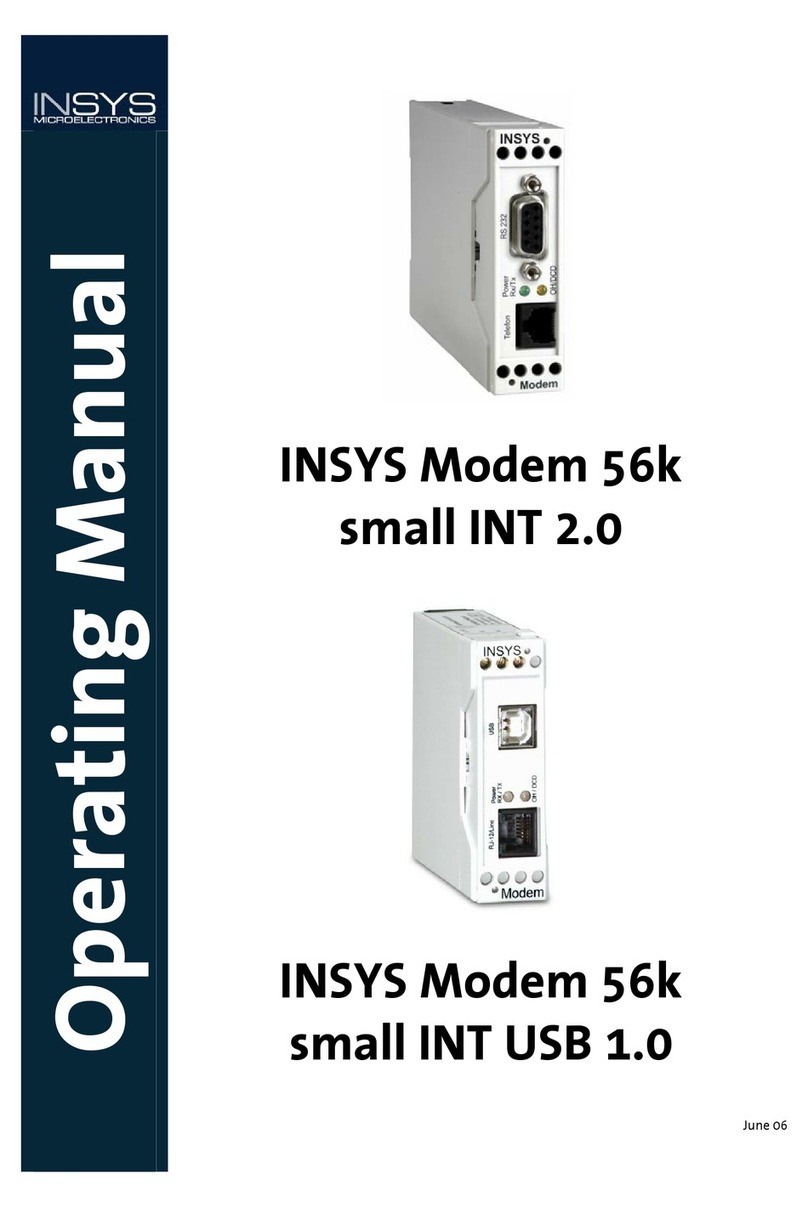
INSYS
INSYS 56k Small INT 2.0 User manual
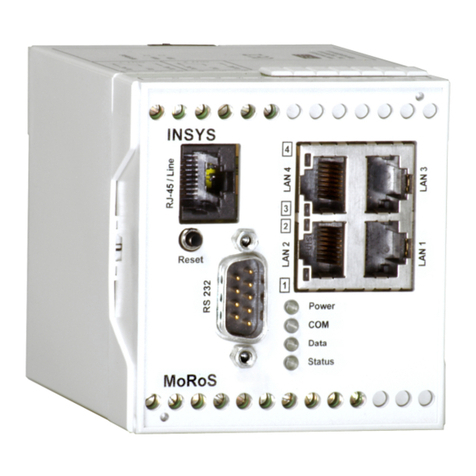
INSYS
INSYS MoRoS User manual

INSYS
INSYS 56k Small INT 2.0 Assembly instructions
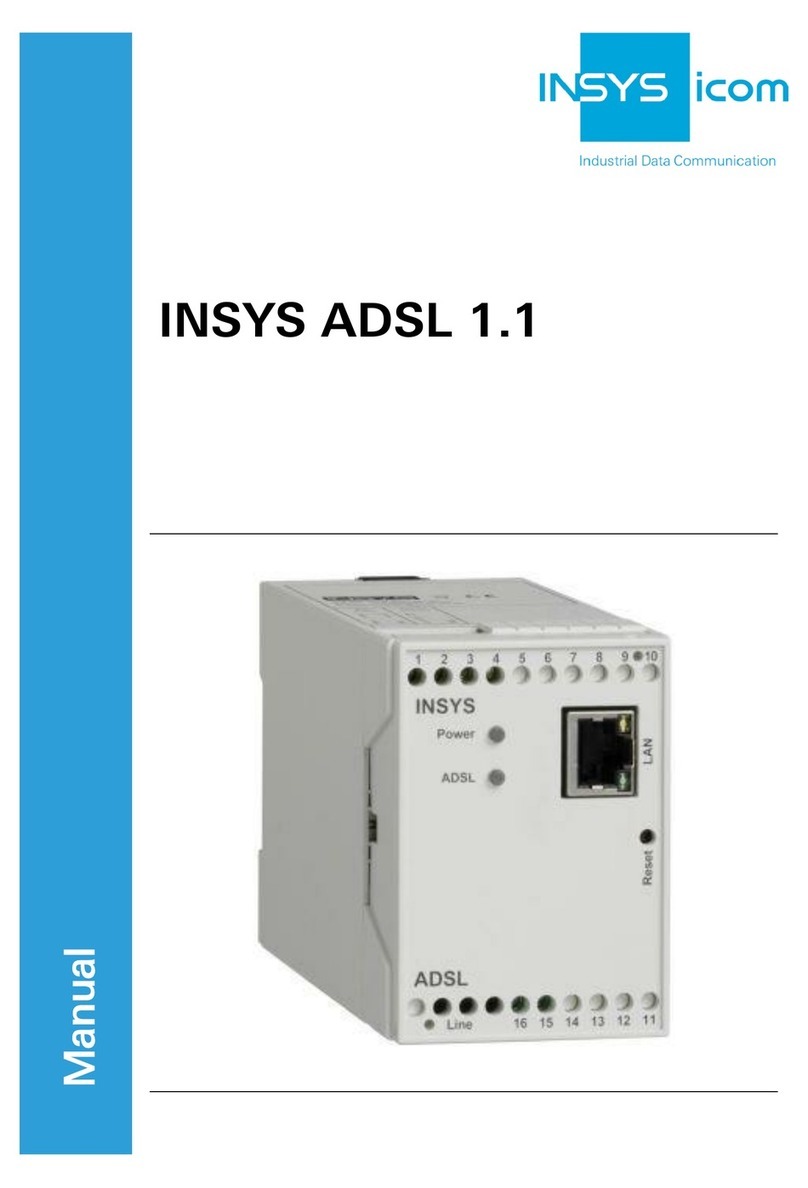
INSYS
INSYS ADSL 1.1 User manual
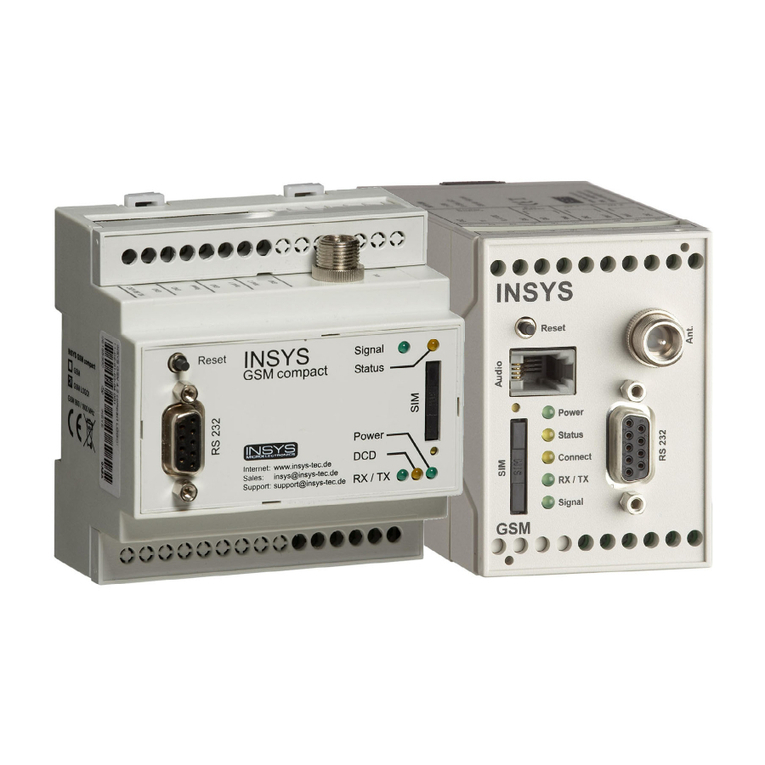
INSYS
INSYS GSM 4.3 easy User manual
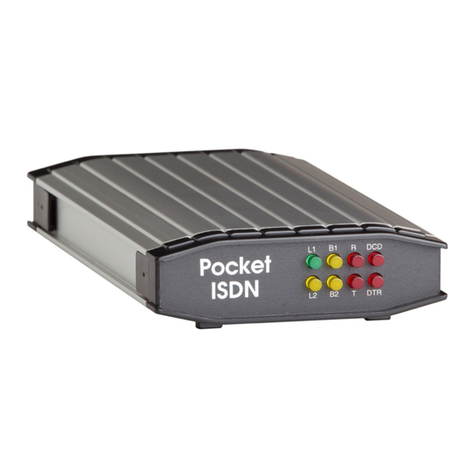
INSYS
INSYS Pocket ISDN User manual
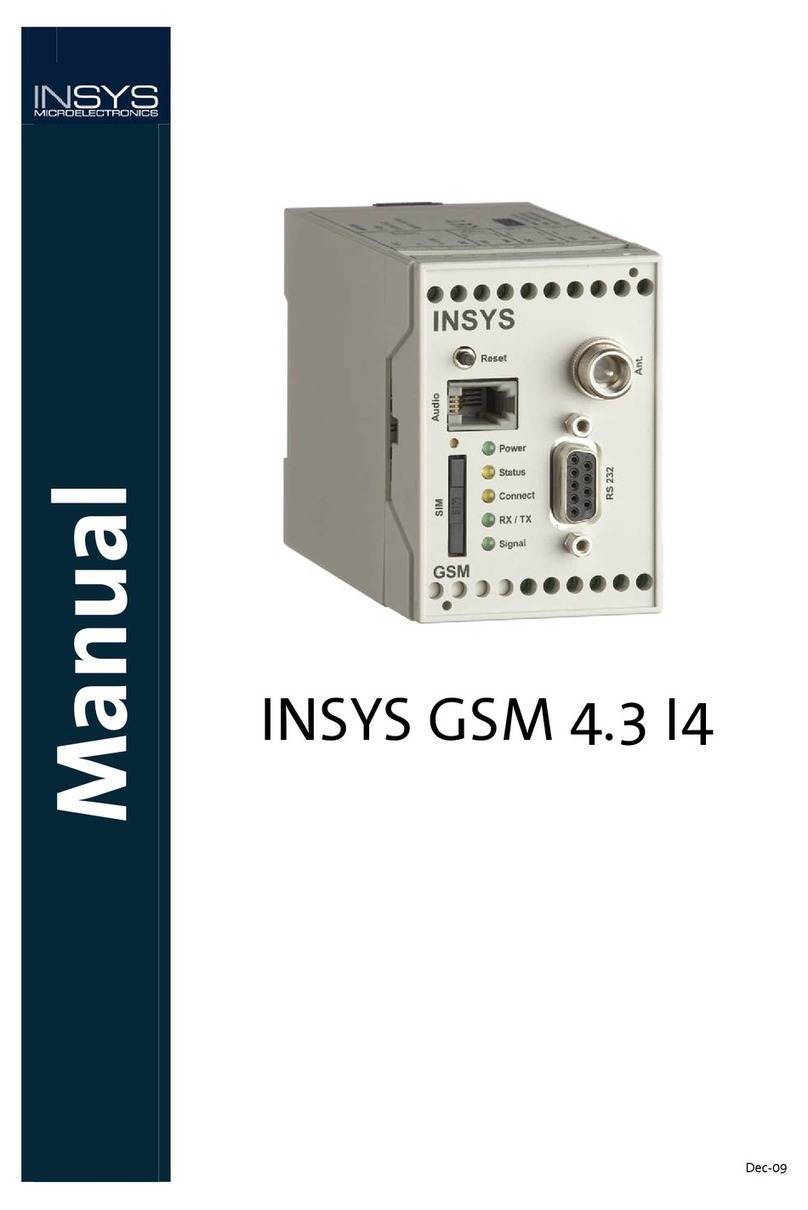
INSYS
INSYS GSM 4.3 I4 User manual

INSYS
INSYS i-modul 336 LL User manual
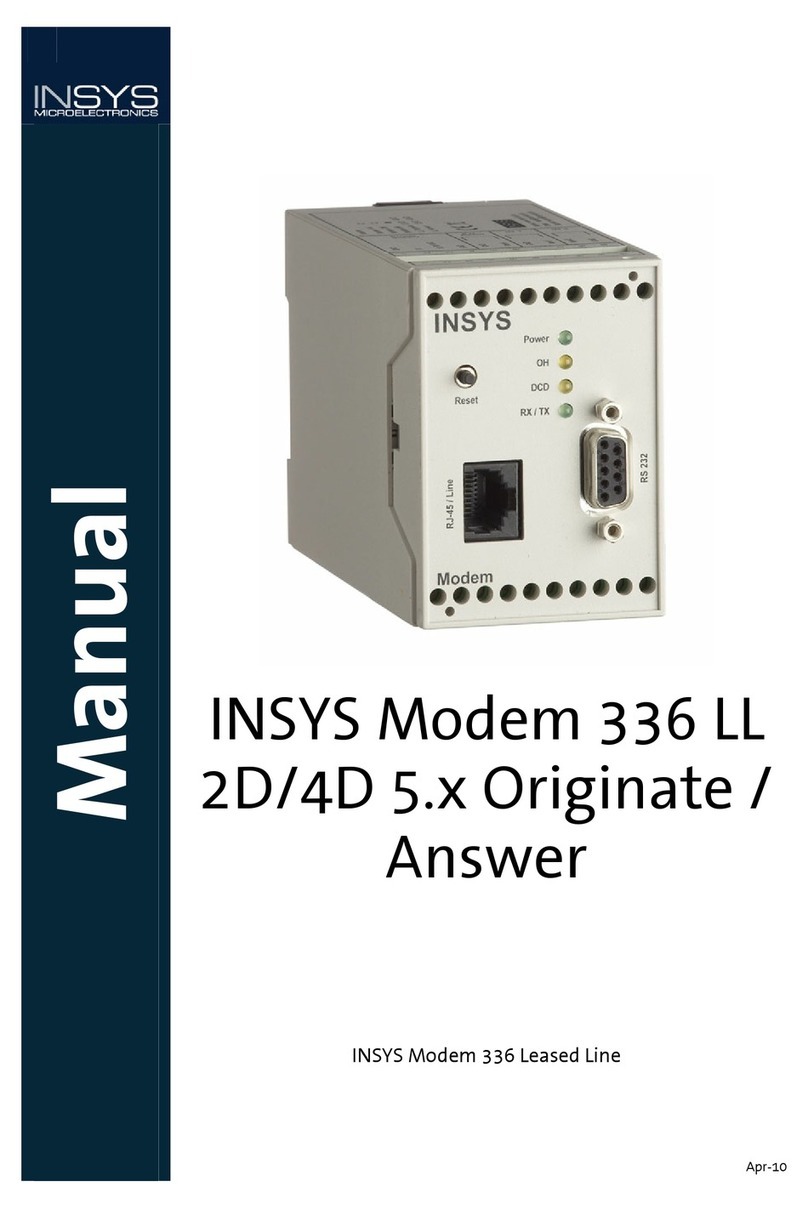
INSYS
INSYS Modem 336 LL 2D/4D 5.x Originate / Answer User manual

